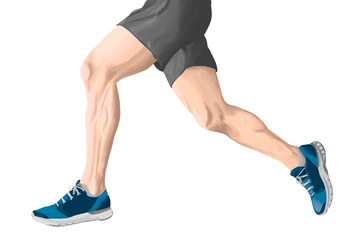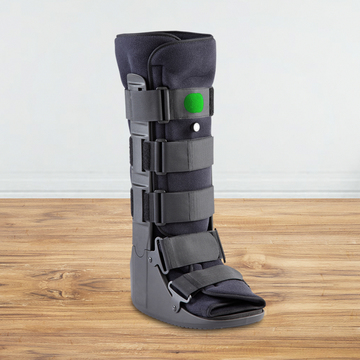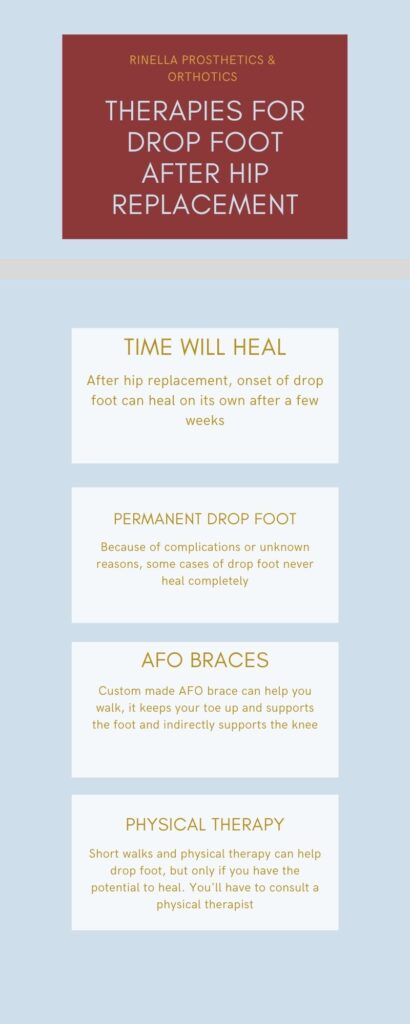
Among the people we have heard from in this patient population, there have been some mixed answers.
We will summarize our findings of each person who discussed this situation with us and put it here.
The responses we got were as follows :
Person 1.) My doctor told me to wait a couple weeks after my hip replacement and there could be some return on my foot drop.
Person 2.) I was told to wait for a few weeks for some drop foot recovery and it never happened. To this day I have to use a walker. The drop foot never went away.
Person 3.) Honestly, some people recover from a DF (drop foot) and some do not.
Person 4.) I was told that my drop foot should recover within six weeks but it did not recover. I am at 9 plus months now and have been now told that whatever happens by the 18th month mark, will be what it will be. I have now accepted that the notion that my drop foot is now permanent.
Person 5.) As long as I wear my afo braces, I can walk normally. My foot drop is permanent.
Below is a picture of a custom made AFO brace that can help with keeping your toe up as you walk. It also can help with knee weakness indirectly which is helpful if the knee snaps back or buckles forward uncontrollably.

Person 6.) As long as I wear my “Dictus band” I can basically do everything I used to do. However, I have to be more cautious and do my activities a little more slowly. (For more information the dictus band, please go to dictus band.com – It is essentially a device to help hold up the foot and wraps around above the ankle and ties into the shoe laces to help hold up the foot.)
If you are looking to an alternative to the product named above you can check out the Foot Up, or you can call a company like ours to supply the brace to you. As long as it has a hcpc code, a company like ours or anyone that provides prosthetic and orthotic services should be able to get you a walking support you need so your foot does not drag when you walk.
If you have never searched for these companies online then you can do a search for : orthotics prosthetics company + your zip code.
Then we suggest checking out their google reviews and calling them to see if they come out to you and if they take your insurance.

How Common Is Drop Foot After Hip Replacement ?
Foot drop is a complication that is universally accepted as a possibility after a hip replacement. Although the percentages are low patient’s with a THR (total hip replacement) can see an incidence of nerve palsy that is related to the sciatic nerve. According to many studies shown online, sciatic nerve palsy can be occur in 3 percent of revision surgeries and in 1 percent of primary hip surgeries.
What Causes Drop Foot After A Total Hip Replacement (THR)?
The peroneal nerve can be compromised during a hip surgery. Sometimes the nerve is compressed. The peroneal nerve helps to dorsiflex the foot (bring it up) when you walk. The nerve has a lot of effect on the muscles that lift the foot and if it is compromised, then the toe will drag.
How Do You Get Rid of a Limp After a Hip Replacement ?
It depends on who bad the injury is that you have. You should consult a physical therapist for exercises in this regard. If you find that your condition is permanent or you want some extra help, you should consider obtaining a walking aid called an AFO. You can see them on our site here, but you can get them at many places locally.
What Main Nerve is Affected by a Hip Replacement ?
The main nerve affected by a THA (Total hip arthroplasy) is the sciatic nerve. A branch of the sciatic nerve is the peroneal nerve as seen above.
Does Walking Help Drop Foot?
Walking can help drop foot if you have the potential to heal to 100 %. Not everyone is able to do that. One of the main goals in physical therapy for foot drop for example is to improve the ability to stay mobile. In other words, to improve the mobility as it relates to walking. If the nerve and muscles can not be rehabilitated, therapy might also be useful for lowering your risk of falls.
Can Foot Drop Be Corrected By Exercise?
If the nerve that controls the muscles in the foot is intact it is possible that exercise can correct a foot drop. If the nerve needs to heal this could take a long time and is often measured in months and years, instead of days and weeks.
Sometimes people make the mistake of thinking it is a tired muscle, or a muscle that doesn’t work correctly. It is possible that your muscles get tired and later in the day it is harder to pick up the foot when you walk and exercise could help that.
Either way, it is best to check the nerve viability and then also consult a physical therapist for the best exercise routines to help you strengthen those muscles.
Is Tingling a Sign of Nerve Healing?
One study that we read has stated that it is a good idea to carefully differentiate a tingling sensation to that of one that is causing you pain. Sometimes pain can occur when you have pressure / compression on the injured nerve in your lower extremity (your leg).
Some people have stated that pain is a sign that your nerves are irritated and that “tingling” indicates that you have the presence of “young axons” that are in the process of regenerating.
Can A Herniated Disc in My Back Cause Drop Foot?
The simple answer to this question is yes. As you have seen in our post earlier the sciatic nerve is connected to other nerves in the lower extremities (ie your legs). If the herniated disc, often times in the lower lumbar area at L4-L5 presses on the sciatic nerve this can affect your ability to raise your feet when you walk.
The good news is that many times herniated discs can get better when given enough time. Most do not require surgery. If the disc heals by itself, then the drop foot can also be relieved.
Is There Pain Associated With Drop Foot?
Not always. Some people are totally numb and can not feel a thing. Others note that they can feel everything as their sensation is not compromised and there is no pain. While this may be true for many individuals, numbness and foot pain have been noted as a complication associated with foot drop and can not be excluded. If you’d like to read more on pain management for charcot foot, check this blog post.
What Causes Sudden Onset of Foot Drop?
Damage to the nerves we have spoken of earlier in this article can cause sudden foot drop. The common peroneal nerve is a nerve in the lower leg and often times can cause foot drop when injured. Other individuals have noted that damage to the peripheral nerve, other issues such as leg compartment syndromes, peripheral polyneuropathies and conditions such as diabetes mellitus can cause foot drop as well at varying speeds.
What Are The Symptoms of Foot Drop ?
Often times people state that they have trouble lifting their toes. They can compensate with what is called a high steppage gait, or a marchers step to help them clear their foot with each step. Below is a picture of that movement in a sequence. You will see that it resembles the person trying to walk over an imaginary object like a can, or small puddle of water.

Other symptoms have been reported as having tingling in their legs or feet, as well as weakness in the lower extremities. For more information, visit this blog on early signs of charcot foot.
- In the end, drop foot recovery is an individual / case by case situation. Some people do recover and unfortunately some do not but you can do things about it if your foot drags when you walk. As stated above, you can check out therapy, AFOs, a Dictus band, the Foot Up and the Walk Aide.
